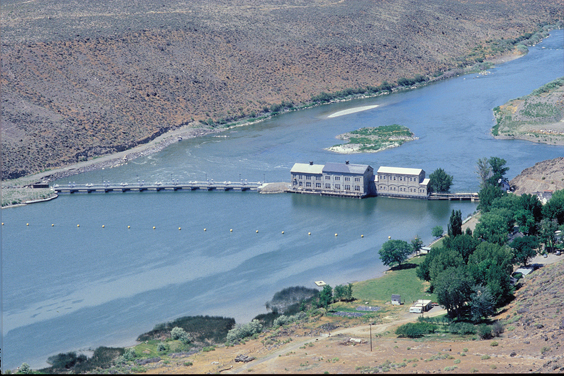Well water in the middle of the river actually slides along the water on the outsides which is slower. So I imagine in deeper channels the water has more to slide on if that makes since. Also boulders in the river are a resistance that slows the water down in one spot and speeds it up elsewhere. But rivers will run faster over high levels in the bed.
The two things that matter most is the flow rate, and the width of the passage.
The flow rate is roughly the horsepower it is capable of generating. And the width tells how much equipment must be used to capture that flow. This is why high flow but narrower waterways are preferred for power generation, as they can provide more flow to sustain that generation. But this can be circumvented entirely, so long as there is somewhere to sequester the water instead.
But the big downside is that outside of a few larger rivers (Mississippi, Columbia), that flow is very seasonal. For example, the Sacramento River in California can vary from over 40k cubic feet per second (cfs) in the early Spring, all the way down to about 12k cfs in late Autumn. I used to drive over that river every day, and the difference in seasons could be striking. One month only a small flow in the center of the channel and wide banks on both sides. Then just two months later almost cresting the dikes on both sides that keep it contained.
Above is a great example of this. The "Yolo Bypass", just west of Sacramento. That is I-80 that is running through the center. In total, just under 60,000 acres, and the water in that basin will average from 15-20 feet in the Spring. All that water you see, come March it will be dry, and most of it is actually farmland.
Roughly the same place in the late Spring, looking to the East. That is Downtown Sacramento in the background. Flooding was such a problem in that city since it was founded, that the Army Corps of Engineers came up with that solution to help stop it. That is why the city comes to an abrupt end to the West, and all growth is in the other three directions.
And remember, a lot of that water comes from the Feather River. That is the river the Oroville Dam sits on, and almost failed 4 years ago. And those of us that live in the area are used to seeing the think almost full in the early Spring, and damned near empty by October. A lot of water flows annually down that river, but mostly in just a few months unless it was sequestered.
We laugh almost every year, because that is often where the news agencies take their photographs to show how bad the drought is. Normally in summer, after a lot of the water had been released for irrigating the Spring crops. This is a typical view of the Bidwell Bar Bridge The left image is typical spring, notice the green plants everywhere. Then the right is late summer, notice how brown everything is, and how low the water is.
And this is probably in July, because in August-September the reservoir is almost empty. Both to provide as much area as possible to save water come winter, and to provide enough flow for the salmon that are migrating at that time. By late Fall, that will be damned near to the original river bed, as unless there is enough flow the salmon can not make it upstream.



